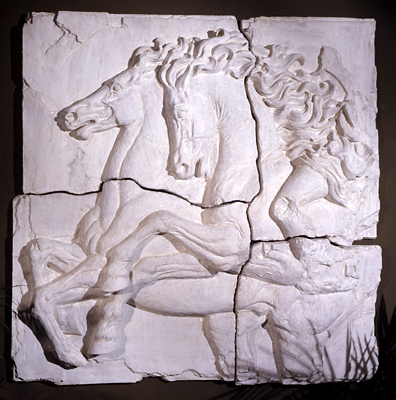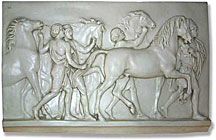Horse Centered Equitation-What Does That Mean?


If I’ve learned anything about the horse business, it’s that everyone has an opinion—and every one of those opinions is “right”. There is no shortage of clinicians, teaching this method or that; show rings, promoting this breed or that; and somewhere in between, riders who tout that this discipline or that is the most “correct” way of riding.
Somewhere along the way, the horse was lost.
From our perspective, in the twenty-first century, it’s difficult to imagine a time when horses were the center of civilization. A time when nations were born, conquered and destroyed, from the back of a horse. A time when information traveled by riders, carrying scrolls, and adventurers has vast expanses of unknown territory to explore and map. This was a time when horses were not a matter of recreation. They were essential to the existence and advancement of civilization, and as such, the preparation of a horse was no light matter.
This was a time when the education and preparation of the horse revolved around….the horse.
There was a time, when an effort was made to communicate with the horse, in his language of choice. The horse’s native language was chosen, because every possible effort was made to help the horse to become a successful student. A true teacher does not want their pupil to fail—they want to put all available tools before their student, which will prepare them for the responsibilities that lie ahead, to help them to become brilliant, and reach their full potential. Using the horse’s native language is perhaps the single-most effective way to communicate with him, and therefore, one of the most useful ways we can contribute to his education.
Why teach a horse English, French or German, when we can speak to him in “Herd”? Well, to start with, I would imagine it’s because many people do not know Herd. Perhaps, some people are not aware of the existence of the language Herd. It’s not a vocal language, as we humans are accustomed to, but rather, a tactile one, and as such, illusive to many. But for those of us who have worked long hours tending one--a herd, that is--there is no mystery. A touch of this quarter sends the animal that way. A touch of that quarter sends him another way. They seek and shoot for openings (sometimes, much to our chagrin), and prefer to avoid objects blocking their path. It’s a rather simple language, and usually, a very quiet one. There is not always a need to touch here or there. Sometimes a gesture or a glance in a particular direction is enough.
Horse centered equitation is not about using an elaborate series of cues, oppositional forces or brute strength, or even teaching horses to perform on vocal command. Horse centered equitation begins with a conversation with the horse, using his language, to suggest a position which will allow him to carry a rider and move as comfortably and athletically as possible, and then, attend to and respect his response. In this way, with mutual understanding between the horse and rider, dialogue may begin. There is no need for special tack, particular breeding, or fashionable clothing.
Somewhere along the way, the horse was lost.
From our perspective, in the twenty-first century, it’s difficult to imagine a time when horses were the center of civilization. A time when nations were born, conquered and destroyed, from the back of a horse. A time when information traveled by riders, carrying scrolls, and adventurers has vast expanses of unknown territory to explore and map. This was a time when horses were not a matter of recreation. They were essential to the existence and advancement of civilization, and as such, the preparation of a horse was no light matter.
This was a time when the education and preparation of the horse revolved around….the horse.
There was a time, when an effort was made to communicate with the horse, in his language of choice. The horse’s native language was chosen, because every possible effort was made to help the horse to become a successful student. A true teacher does not want their pupil to fail—they want to put all available tools before their student, which will prepare them for the responsibilities that lie ahead, to help them to become brilliant, and reach their full potential. Using the horse’s native language is perhaps the single-most effective way to communicate with him, and therefore, one of the most useful ways we can contribute to his education.
Why teach a horse English, French or German, when we can speak to him in “Herd”? Well, to start with, I would imagine it’s because many people do not know Herd. Perhaps, some people are not aware of the existence of the language Herd. It’s not a vocal language, as we humans are accustomed to, but rather, a tactile one, and as such, illusive to many. But for those of us who have worked long hours tending one--a herd, that is--there is no mystery. A touch of this quarter sends the animal that way. A touch of that quarter sends him another way. They seek and shoot for openings (sometimes, much to our chagrin), and prefer to avoid objects blocking their path. It’s a rather simple language, and usually, a very quiet one. There is not always a need to touch here or there. Sometimes a gesture or a glance in a particular direction is enough.
Horse centered equitation is not about using an elaborate series of cues, oppositional forces or brute strength, or even teaching horses to perform on vocal command. Horse centered equitation begins with a conversation with the horse, using his language, to suggest a position which will allow him to carry a rider and move as comfortably and athletically as possible, and then, attend to and respect his response. In this way, with mutual understanding between the horse and rider, dialogue may begin. There is no need for special tack, particular breeding, or fashionable clothing.
Sharing a mutually understood language is the first step to “rediscovering” the horse.
9.9.2011 TME
return to Educated Equestrian
9.9.2011 TME
return to Educated Equestrian